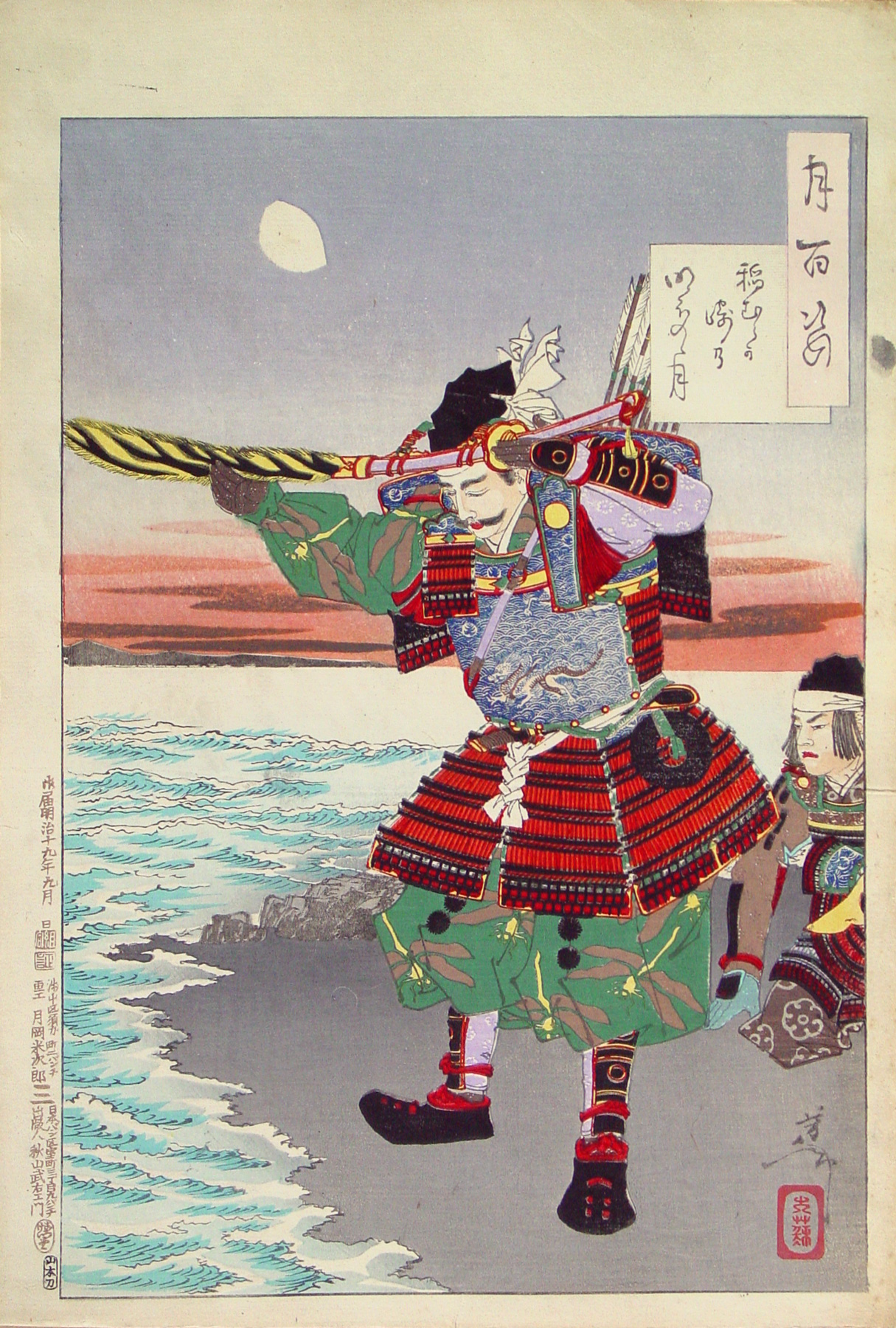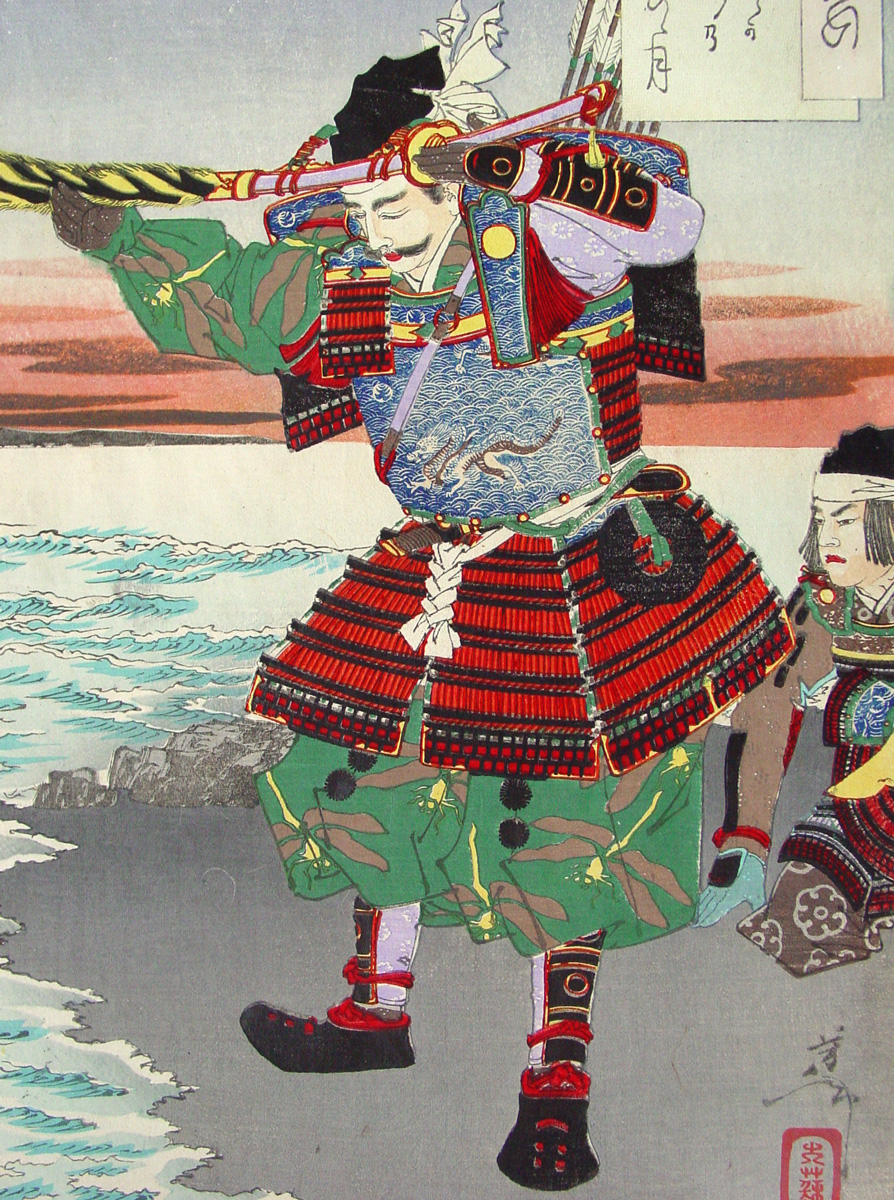About This Print
Source: Museum of International Folk Art http://www.internationalfolkart.org/exhibitions/past/moonweb/section2/067.htm
An early, if not first, state of this print, with the ink used to create the sunrise and clouds partially oxidized as intended.
The Story Depicted in the Print as Told by John Stevenson
Source: Yoshitoshi's One Hundred Aspects of the Moon, John Stevenson, Hotei Publishing, Netherlands 2001.39.
Inamura Promontory moon at daybreak
Inamuragasaki no akebono no tsuki
Nitta no Yoshisada, the subject of this design, was general in the Hōjō army who found himself increasingly alienated from Takatoki, vicious leader of the Hojo clan. When Emperor Go-Daigo escaped from exile in 1333 and challenged the Hojo, Yoshisada immediately declared support for him. He raised a force of twenty thousand men and advanced on the Hōjō stronghold in Kamakura, a town by the sea.
As Yoshisada and his army marched along the narrow shore towards Kamakura, they found themselves trapped at Inamura Promontory. The cliffs commanding the approaches to the city were heavily fortified, while enemy warships filled with archers threatened them from the sea. Yoshisada ordered his army to halt while he prayed to the deities of the sea, finally casting his sword into the waves as a token of his sincerity. As the sun rose, the tide ebbed far beyond normal, carrying with it the ships with their archers. A wide expanse of sand was left, over which Yoshisada and his men were able to advance against Kamakura. The Hojo power base was destroyed, and Emperor Go-Daigo entered Kyoto in triumph.
Yoshisada’s sleeves and trousers are decorated with magnificent dragonflies – perhaps this motif was chosen to suggest the ease with which a dragonfly skims over the water. The round black object at Yoshisada’s waist is part of his scabbard. His breastplate has been engraved with a complex design of a dragon, an appropriate reference to the Dragon King who ruled the sea, especially as the breastplate design includes the “ebb-and-flow” jewels that the Dragon King coveted. Yoshitoshi’s audience would also have recognized in the dragon an allusion to Nitta Yoshisada’s famous dragon war-helmet, the identification of which takes up the first act of the Kabuki play Kanadehon chūshingura.
Inamuragasaki no akebono no tsuki
Nitta no Yoshisada, the subject of this design, was general in the Hōjō army who found himself increasingly alienated from Takatoki, vicious leader of the Hojo clan. When Emperor Go-Daigo escaped from exile in 1333 and challenged the Hojo, Yoshisada immediately declared support for him. He raised a force of twenty thousand men and advanced on the Hōjō stronghold in Kamakura, a town by the sea.
As Yoshisada and his army marched along the narrow shore towards Kamakura, they found themselves trapped at Inamura Promontory. The cliffs commanding the approaches to the city were heavily fortified, while enemy warships filled with archers threatened them from the sea. Yoshisada ordered his army to halt while he prayed to the deities of the sea, finally casting his sword into the waves as a token of his sincerity. As the sun rose, the tide ebbed far beyond normal, carrying with it the ships with their archers. A wide expanse of sand was left, over which Yoshisada and his men were able to advance against Kamakura. The Hojo power base was destroyed, and Emperor Go-Daigo entered Kyoto in triumph.
Yoshisada’s sleeves and trousers are decorated with magnificent dragonflies – perhaps this motif was chosen to suggest the ease with which a dragonfly skims over the water. The round black object at Yoshisada’s waist is part of his scabbard. His breastplate has been engraved with a complex design of a dragon, an appropriate reference to the Dragon King who ruled the sea, especially as the breastplate design includes the “ebb-and-flow” jewels that the Dragon King coveted. Yoshitoshi’s audience would also have recognized in the dragon an allusion to Nitta Yoshisada’s famous dragon war-helmet, the identification of which takes up the first act of the Kabuki play Kanadehon chūshingura.
Yoshisada met his wife when he spied her through the hedge of her garden, playing a koto in the moonlight. He immediately composed the poem,
tears wet my sleeves
the moon shines form above the clouds
unaware of having caused them
Within a year the two were married. In 1338 Yoshisada was killed in battle and his head exhibited in Kyoto, which was now controlled by Go-Daigo’s enemies. Unaware of this, his wife came to Kyoto to meet him, saw the head, and retired to a nunnery.
The dawn light in this design has been printed with a mercuric pigment which would have been orange when the print was first made. It has since oxidized into the color of morning clouds. Such pigments were expensive and used in the printing of the finest impressions of ukiyo-e. It is assumed that they were chosen specifically for the shades given by their eventual oxidation, but western collectors did not always believe that the effect was intentional. Instructions on the “care” of prints at the beginning of this century included directions on how to remove oxidation with strong chemicals, together with such ideas as boiling a print in tea to give it an aged look.
Image from Publisher's Bound Album (Issued shortly after Yoshitoshi's death)
New York Public Library Digital Gallery
About the Series "One Hundred Aspects of the Moon"For details about this series which consists of one hundred prints with the moon as a unifying motif, see the article on this site Yoshitoshi, One Hundred Aspects of the Moon.
Print Details
| IHL Catalog | #88 |
| Title | Inamura Promontory Moon at Daybreak (Inamuragasaki no akebono no tsuki 稲むらか崎の明ほのゝ月) |
| Series | One Hundred Aspects of the Moon (Tsuki hyaku sugata 月百姿) |
| John Stevens Reference No.* | 39 |
| Artist | Tsukioka Yoshitoshi (1839-1892) |
| Signature | Yoshitoshi 芳年 |
| Seal | Taiso 大蘇 |
| Date | September 1886 (御届明治十九年九月 日) |
| Edition | A single sheet issue, not bound into an album. An early state of the print. |
| Publisher | Akiyama Buemon (秋山武右エ門) [Marks: seal 26-132; pub. ref. 005] |
| Carver | Yamamoto carver 山本刀 |
| Impression | excellent |
| Colors | excellent |
| Condition | good - light toning, slightly soiled, upper margin and right margin lightly soiled, a ink spot and some foxing on the right margin, slight green ink stain on middle right, green color bleeding on his right forearm, not backed (original state) |
| Genre | ukiyo-e |
| Miscellaneous | |
| Format | oban |
| H x W Paper | 14 1/2 x 9 7/8 in. (36.8 x 25.1 cm) |
| H x W Image | 12 7/8 x 8 3/4 in. (32.7 x 22.2 cm) |
| Collections This Print | Yale University Art Gallery 2011.143.1.39; Hagi Uragami Museum (Yamaguchi, Japan) UO3349; Tokyo Metropolitan Library 加4722-43; The Tsubouchi Memorial Theatre Museum of Waseda University 201-4488; Ritsumeikan University ARC NDL-541-00-021; Worcester Art Museum 2002.195 |
| Reference Literature | * Yoshitoshi’s One Hundred Aspects of the Moon, John Stevenson, Hotei Publishing, Netherlands 2001, pl. 39. |




